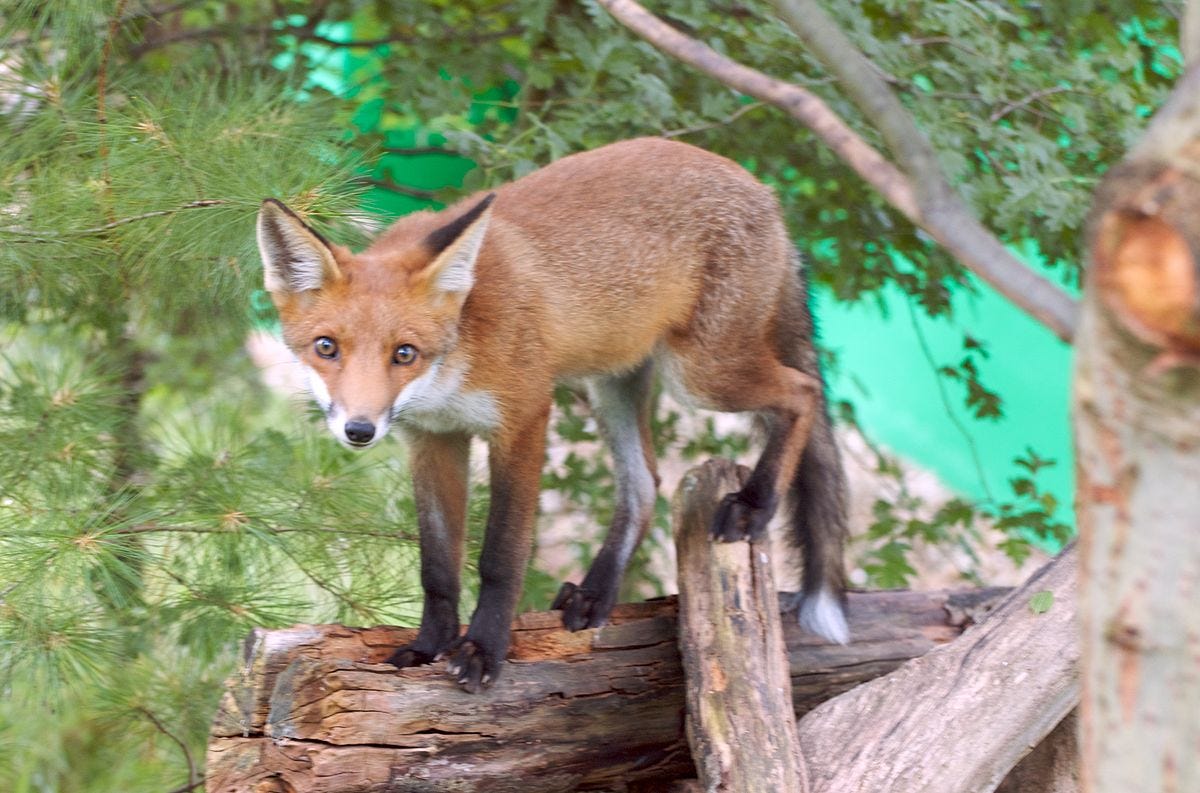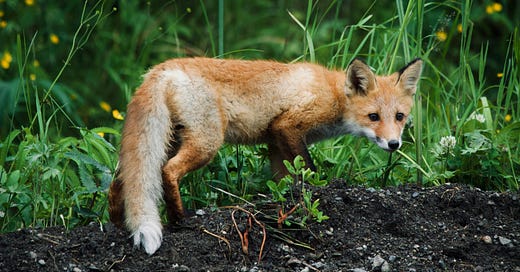
About a month ago, when driving home in the dark after unsuccessfully searching for the Northern Lights (we were a day too late), our headlights passed over a tiny fox kit near our mailbox. We had recently had a red fox visit our yard in the broad daylight and this may have been one of its offspring.
Foxes are beautiful creatures, an odd blend of the physical features of dogs and the behavioral characteristics of cats. I remember my dad telling me stories about how foxes trick the dogs that chase them by running through water or backtracking their steps. He also described how foxes apparently get rid of fleas: they hold a small stick in their mouth then slowly back into a pond, so slowly the fleas travel up the body to get away from the water. Eventually, the fleas are all gathered on the stick so the fox releases it and climbs out of the pond leaving them to float away while the fox is itch-free.
I know foxes are smart, but are they that smart?
Foxes are sly and intelligent, leading humans to add them as tricksters to folktales the world over. They can outwit humans and hunting dogs, and even play dead to avoid capture. But not long ago when I was visiting our local nature center, the guide mentioned in an offhand way that foxes can climb trees. She claimed a female fox might stash her young kits in a tree hole as a safety measure. I know they act a lot like cats, but – climb trees? Really? I knew I had to do some research.
Can foxes climb trees?
All foxes can balance on leaning trees enough to appear to be able to climb trees. Even domesticated dogs can climb trees, sometimes with tragic results, like this hound dog that got stuck 28 feet up the inside of a chestnut oak and wasn’t found for 20 years (warning: if you click that link, be prepared for a terrifying picture of a mummified dog).

So, balancing on slightly tilting trees, while a dedicated approach to hunting, might not be considered truly “climbing” a tree. Red foxes can complete these balancing acts, but that’s about it.
Grey foxes, on the other hand, are able to scale a completely vertical tree just like a cat would. Take a look at this video of several young grey foxes cavorting up and down and into trees in a backyard in Texas:
There’s no arguing that those foxes are climbing trees. Grey foxes are able to do this because of their semi-retractable claws, which remain sharp and protected from wear and tear. These foxes are the only members of the dog family that can climb, and they use this superpower to escape from one of their major predators – coyotes.
Grey foxes live mainly in forested areas from southern Canada all the way south to parts of South America. They are omnivores, just like coyotes, meaning they eat meat (small rodents, insects, birds) as well as plants (fruit and vegetation). It’s one of the reasons foxes and coyotes are so resilient – if one food source becomes scarce, they switch to another.
But since foxes are smaller than coyotes, they tend to get persecuted by them. Both animals are competing for the same food sources, so foxes tend to live where coyotes are scarce. This may be one reason we’re suddenly seeing red foxes near our house – we haven’t heard the yipping of coyotes for a few years now, so they may have moved out.

Grey foxes are slightly smaller than red foxes. They are mostly grey-silver with a touch of red around their head, whereas red foxes are mostly red with a white-tipped tail. The red fox visiting our yard is very light – almost a champagne color.
Another fascinating fact about foxes? They appear to use the Earth’s magnetic field to hunt – researchers have noticed when foxes pounce on prey they are almost always aligned to the northeast. Pounces are successful 72% of the time when aligned this way, compared to 18% effective when pointed in other directions. Scientists posit that foxes see a “ring of shadow” on their retinas that allows them to line up to magnetic north, like a sniper zeroing in on a target.
Because foxes are ambush hunters, they have oval or slit pupils, which allow for greater depth perception. This differs from wolf and domesticated dogs, who have round pupils (I wrote about this in-depth in January).
As for the story about foxes defleaing themselves, that tale has been told the world over. This site by the University of Pittsburgh has compiled fox de-lousing stories from India, Scotland, Denmark, Norway, and Germany, and the only difference is what they hold in their mouths as they back into the water (Sticks? Moss? Balls of wool?).
But is it true? Despite the tale being told since Hellenic times dating back to 323 B.C., probably not. Fox fur is like dog fur – it’s unlikely the water penetrates all the way to the skin and so fleas are not likely to make a move for fear of being submerged. However, there are reports of people who’ve witnessed foxes in the act, so it’s nice to think it could be true.
Weird Nature:
(click to watch)






My colleague once had a grey fox that visited her regularly at her research site, but one day it turned up with a large gash in its side. She live trapped it and took it to a vet for rehab, then released it again two weeks later. Her thanks for doing this was that her car stank terribly of musk for weeks, and when we released the fox, it turned around, looked at us pointedly, then defecated and urinated. Never saw it again. Beautiful animal, but be aware of the musk.
I love this to bits! I had no idea that grey foxes could climb trees, but just look at those little fellas go! They are having the best of best times!